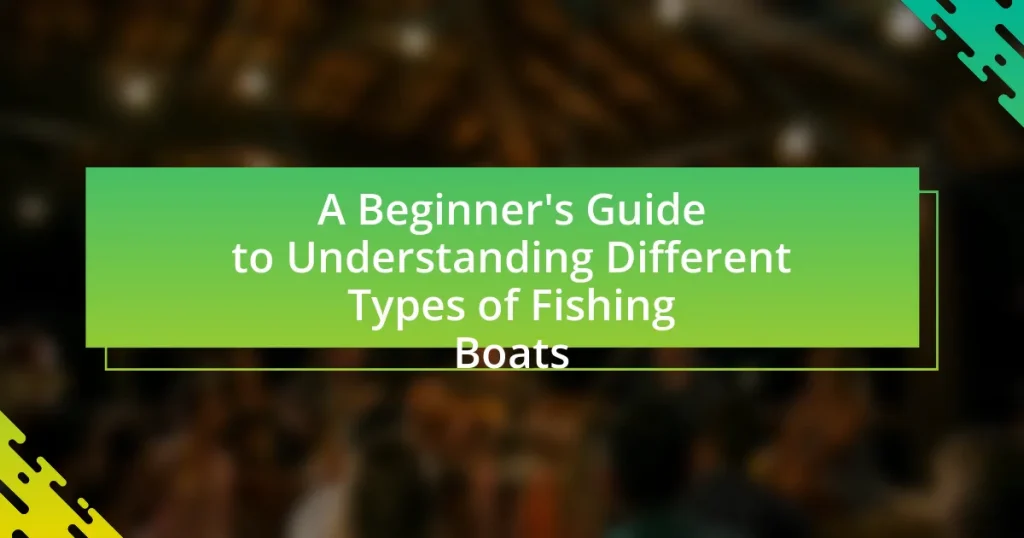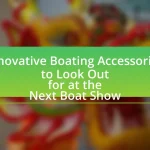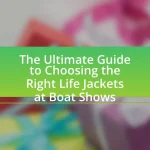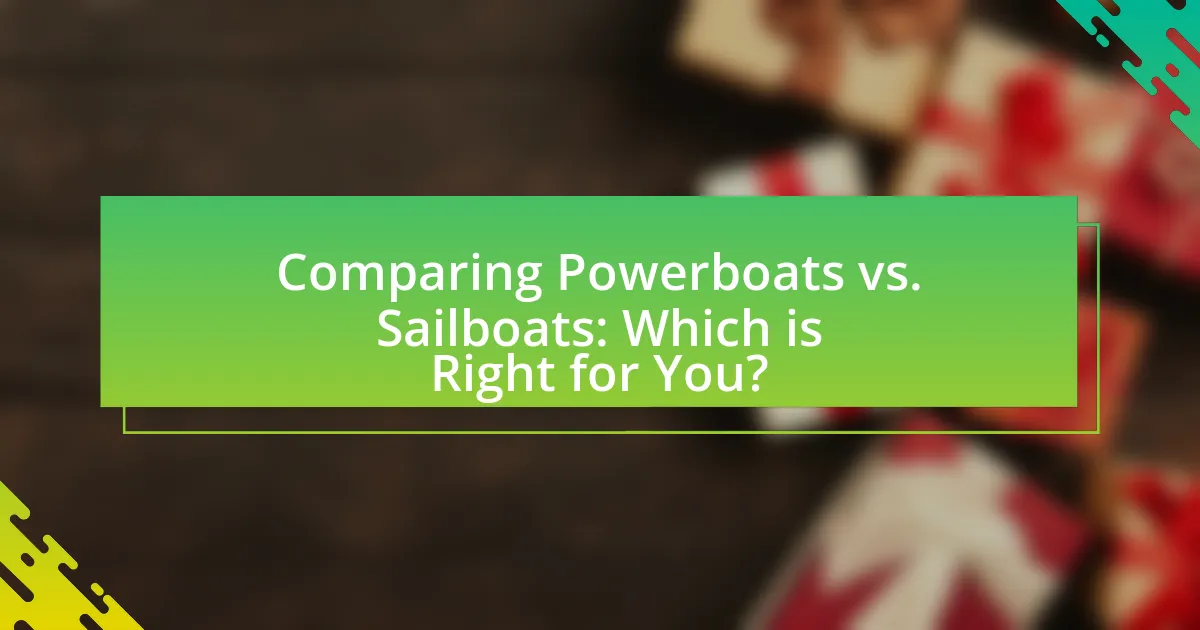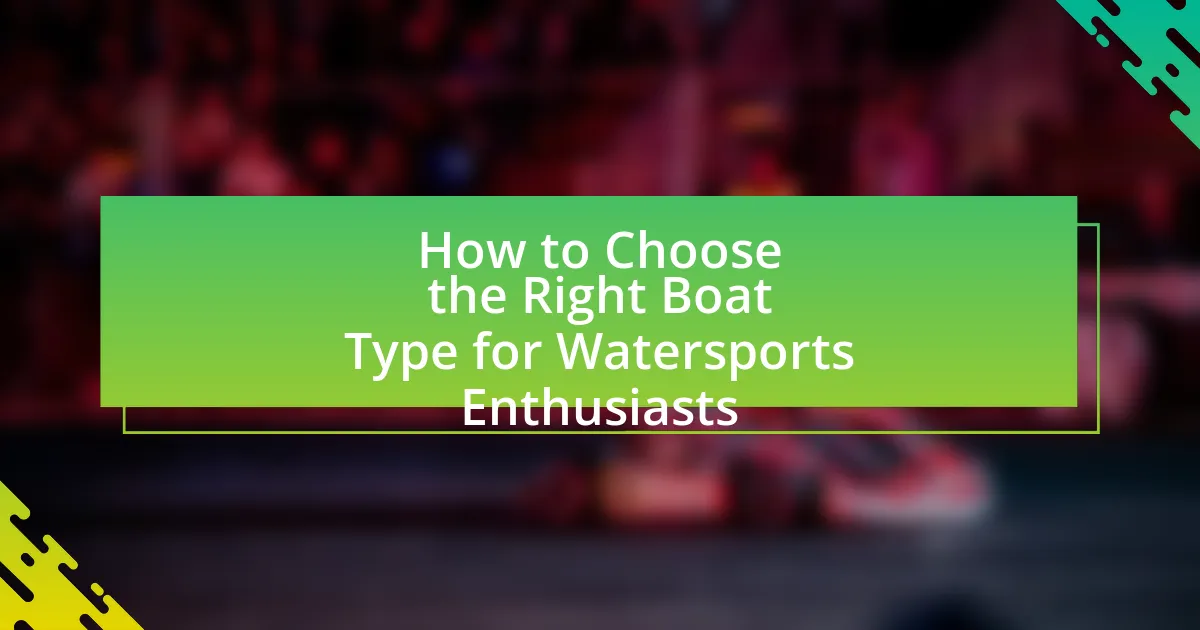The article provides a comprehensive overview of various types of fishing boats, including trawlers, longliners, seiners, and dinghies, each designed for specific fishing methods and environments. It discusses the differences in design and purpose among fishing boats, highlighting key features of small and large vessels, as well as considerations for selecting the right boat based on fishing type and budget. Additionally, the article addresses the advantages and limitations of different boat types, challenges faced by kayak fishermen, and essential tips for beginners to maximize their fishing experience. Overall, it serves as a guide for understanding the diverse options available in fishing boats and their suitability for various fishing activities.
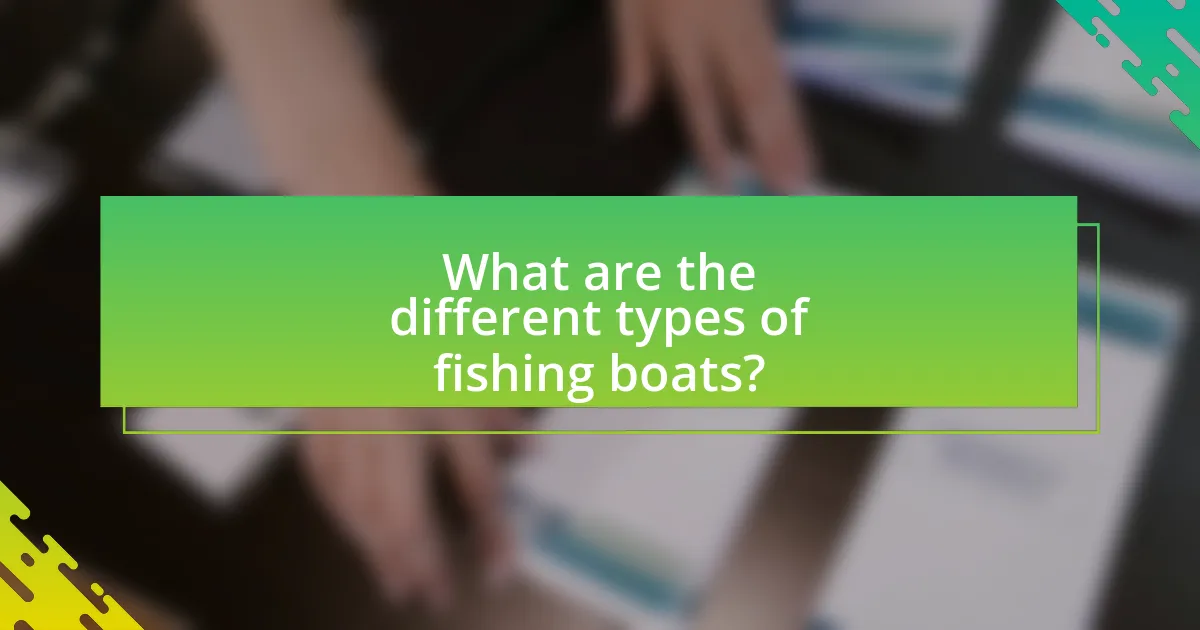
What are the different types of fishing boats?
There are several types of fishing boats, including trawlers, longliners, seiners, and dinghies. Trawlers are designed for dragging nets along the sea floor to catch fish, while longliners use a main line with baited hooks to catch fish over a large area. Seiners employ a large net that encircles schools of fish, and dinghies are small, often used for recreational fishing or inshore fishing. Each type of fishing boat is tailored to specific fishing methods and environments, reflecting the diverse needs of the fishing industry.
How do fishing boats differ in design and purpose?
Fishing boats differ in design and purpose primarily based on the type of fishing they are intended for and the environments in which they operate. For instance, trawlers are designed with large nets for deep-sea fishing, featuring a robust hull to withstand rough waters, while smaller boats like dinghies are used for inshore fishing, emphasizing maneuverability and ease of access to shallow areas. Additionally, the design of longliners includes a long line with baited hooks, allowing for targeting specific fish species, whereas purse seiners utilize a large net to encircle schools of fish. These variations in design reflect the specific operational needs and fishing techniques employed in different fishing practices, ensuring efficiency and effectiveness in catching targeted species.
What are the key features of small fishing boats?
Small fishing boats typically feature a compact design, stability, and ease of maneuverability. These boats are often constructed from durable materials like fiberglass or aluminum, which enhance their longevity and resistance to harsh marine conditions. Additionally, small fishing boats usually include essential equipment such as rod holders, storage compartments for gear, and sometimes live wells for keeping bait alive. Their size allows for easy transport and launching, making them ideal for both novice and experienced anglers. The versatility of small fishing boats enables them to be used in various water bodies, from lakes to coastal areas, catering to different fishing styles.
What distinguishes larger commercial fishing vessels?
Larger commercial fishing vessels are distinguished by their size, capacity, and advanced technology. These vessels typically exceed 50 feet in length and can carry substantial amounts of catch, often equipped with specialized gear for deep-sea fishing. For example, trawlers and longliners, which are common types of larger vessels, can operate in deeper waters and target a variety of fish species, enhancing their efficiency and productivity. Additionally, larger vessels often feature onboard processing facilities, allowing for immediate processing and preservation of the catch, which is crucial for maintaining quality and extending shelf life. This capability is supported by regulations that require certain types of fishing to be conducted on larger vessels to ensure sustainable practices and compliance with fishing quotas.
What factors should be considered when choosing a fishing boat?
When choosing a fishing boat, factors such as size, type, purpose, budget, and storage capacity should be considered. The size of the boat affects stability and the number of passengers it can accommodate; larger boats are typically more stable in rough waters. The type of boat, whether it be a kayak, bass boat, or offshore vessel, should align with the fishing environment, such as freshwater or saltwater. The intended purpose, whether for recreational fishing or commercial use, influences the design and features needed. Budget constraints determine the options available, as prices can vary significantly based on brand and specifications. Lastly, storage capacity is crucial for gear and equipment, impacting the overall fishing experience.
How does the type of fishing influence boat selection?
The type of fishing significantly influences boat selection by determining the required features and specifications of the vessel. For instance, deep-sea fishing necessitates larger boats equipped with powerful engines and advanced navigation systems to handle rough waters, while freshwater fishing often allows for smaller, more maneuverable boats. Additionally, specific fishing methods, such as fly fishing or trolling, may require specialized designs, such as flat-bottomed skiffs for shallow waters or multi-hull boats for stability. These requirements are supported by industry standards, which indicate that the boat’s size, stability, and equipment must align with the fishing environment and techniques employed.
What are the budget considerations for purchasing a fishing boat?
Budget considerations for purchasing a fishing boat include the initial purchase price, ongoing maintenance costs, insurance, fuel expenses, and storage fees. The initial purchase price can vary significantly based on the type and size of the boat, ranging from a few thousand dollars for small used boats to over a hundred thousand for larger, new models. Ongoing maintenance costs, which can average 10% of the boat’s value annually, cover repairs, cleaning, and routine servicing. Insurance costs depend on the boat’s value and usage, typically ranging from 1% to 2% of the boat’s value per year. Fuel expenses fluctuate based on engine type and usage frequency, while storage fees can add up if the boat is kept at a marina or storage facility. These factors collectively impact the overall budget for owning a fishing boat.

What are the advantages of various fishing boat types?
Various fishing boat types offer distinct advantages tailored to specific fishing needs. For instance, trawlers are designed for deep-sea fishing and can carry large catches due to their robust construction and spacious holds. This makes them ideal for commercial fishing operations. In contrast, smaller boats like skiffs are agile and can navigate shallow waters, making them perfect for inshore fishing and accessing areas that larger vessels cannot reach. Additionally, pontoon boats provide stability and ample deck space, which is advantageous for recreational fishing and family outings. Each type of fishing boat is optimized for particular environments and fishing techniques, enhancing efficiency and safety on the water.
How do different fishing boats enhance the fishing experience?
Different fishing boats enhance the fishing experience by providing specialized features that cater to various fishing environments and techniques. For instance, larger boats like trawlers offer stability and storage for extended trips, allowing anglers to target deeper waters and larger species. In contrast, smaller boats such as kayaks enable access to shallow areas and rivers, promoting stealth and a closer connection to nature. Additionally, boats equipped with advanced technology, such as fish finders and GPS, improve the chances of locating fish, thereby increasing the overall success rate of fishing trips. These enhancements are supported by the fact that boat design and equipment directly influence fishing efficiency and comfort, as evidenced by studies showing that anglers using specialized boats report higher satisfaction and catch rates.
What benefits do inflatable fishing boats offer?
Inflatable fishing boats offer several benefits, including portability, ease of storage, and affordability. Their lightweight design allows for easy transport, making them ideal for anglers who need to travel to various fishing locations. Additionally, inflatable boats can be deflated and packed into small spaces, which is advantageous for those with limited storage options. They are generally more cost-effective compared to traditional fishing boats, making them accessible for beginners and casual fishers. Furthermore, many inflatable fishing boats are constructed from durable materials, ensuring they can withstand various water conditions while providing a stable platform for fishing activities.
Why are center console boats popular among anglers?
Center console boats are popular among anglers due to their versatility and ease of movement. These boats feature an open deck layout that allows anglers to fish from all sides, enhancing accessibility and improving the fishing experience. Additionally, center console boats often come equipped with ample storage for gear and tackle, as well as powerful engines that enable quick travel to fishing spots. Their design also provides stability in various water conditions, making them suitable for both inshore and offshore fishing.
What are the limitations of certain fishing boat types?
Certain fishing boat types have limitations that affect their usability and efficiency. For instance, small boats like dinghies are limited by their capacity and stability, making them unsuitable for rough waters or large catches. In contrast, larger vessels such as trawlers may have limitations in maneuverability and require more fuel, which can increase operational costs. Additionally, specialized boats like longliners are restricted by their design, which may not allow for quick retrieval of lines in adverse weather conditions. These limitations are critical for fishermen to consider when selecting a boat type for specific fishing environments and target species.
What challenges do kayak fishermen face?
Kayak fishermen face several challenges, including limited storage space, stability issues, and exposure to weather conditions. The confined space of a kayak restricts the amount of gear and catch that can be transported, making it essential for fishermen to prioritize their equipment. Stability can be compromised, especially in rough waters, which increases the risk of capsizing. Additionally, kayak fishermen are more exposed to the elements, such as sun, wind, and rain, which can lead to discomfort and safety concerns. These challenges necessitate careful planning and skillful navigation to ensure a successful fishing experience.
How do larger boats impact accessibility to fishing spots?
Larger boats can limit accessibility to fishing spots due to their size and draft, which restricts navigation in shallow waters. Many prime fishing locations, such as estuaries and coastal areas, have depth limitations that larger vessels cannot safely traverse, thereby reducing the number of accessible spots for anglers. For instance, a study by the National Oceanic and Atmospheric Administration (NOAA) indicates that boats with a draft exceeding three feet often cannot access shallow fishing grounds, which are crucial for certain species. Consequently, the presence of larger boats can lead to overcrowding in deeper waters, further diminishing the overall fishing experience.
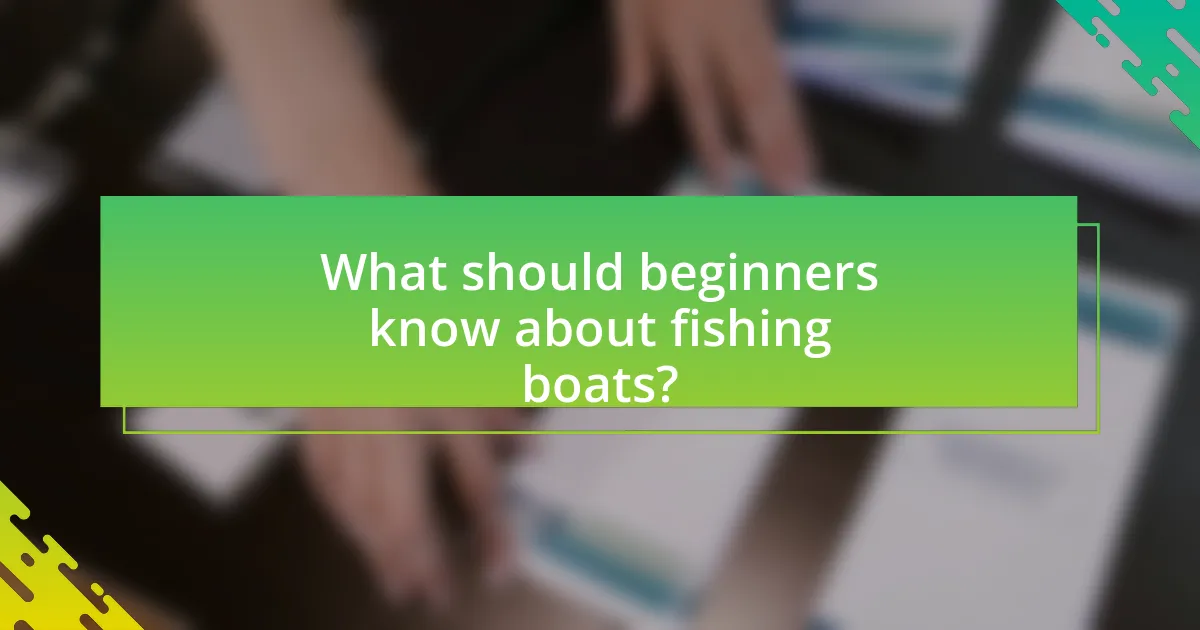
What should beginners know about fishing boats?
Beginners should know that fishing boats vary in type, size, and purpose, which directly affects their suitability for different fishing activities. For instance, small boats like kayaks and canoes are ideal for freshwater fishing in lakes and rivers, while larger vessels such as center console boats are designed for offshore fishing. Additionally, understanding the boat’s features, such as stability, storage capacity, and engine type, is crucial for safety and efficiency on the water. According to the National Marine Manufacturers Association, over 90% of recreational fishing is done from boats, highlighting the importance of selecting the right type for a successful fishing experience.
How can beginners effectively choose their first fishing boat?
Beginners can effectively choose their first fishing boat by assessing their specific fishing needs, budget, and the type of water they will be navigating. Identifying whether they will fish in freshwater or saltwater, and considering the boat’s size and capacity for passengers and gear, are crucial factors. For instance, a small aluminum boat may suffice for freshwater lakes, while a larger fiberglass boat is better suited for ocean fishing. Additionally, beginners should evaluate their budget, as prices can range from a few thousand dollars for used boats to significantly more for new models. Researching local regulations and safety requirements is also essential to ensure compliance and safety on the water.
What are the essential features to look for in a beginner’s fishing boat?
Essential features to look for in a beginner’s fishing boat include stability, ease of handling, and sufficient storage. Stability is crucial for beginners to feel secure while fishing, as it reduces the risk of capsizing. A boat with a wide beam enhances stability, making it easier to navigate. Ease of handling is important for novice users; boats that are lightweight and have a simple steering mechanism allow for better control. Additionally, sufficient storage is necessary to keep fishing gear organized and accessible, which can enhance the overall fishing experience. These features collectively ensure that beginners can enjoy fishing safely and effectively.
How can beginners assess their fishing needs before purchasing?
Beginners can assess their fishing needs before purchasing by identifying the type of fishing they plan to do, the water conditions they will encounter, and the number of people they will typically fish with. Understanding whether they will fish in freshwater or saltwater, for example, influences the choice of boat type, as certain boats are designed specifically for one environment. Additionally, considering the size and capacity of the boat is crucial; a small boat may suffice for solo trips, while larger groups may require a bigger vessel. Research indicates that 70% of new boat owners regret not considering their specific fishing style and environment before purchase, highlighting the importance of this assessment.
What are some common mistakes to avoid when buying a fishing boat?
Common mistakes to avoid when buying a fishing boat include not considering the boat’s intended use, overlooking maintenance costs, and failing to test the boat before purchase. Buyers often neglect to assess whether the boat is suitable for their specific fishing needs, such as size and type of water. Additionally, many do not factor in ongoing expenses like insurance, fuel, and repairs, which can significantly impact overall ownership costs. Lastly, skipping a test drive can lead to purchasing a boat that does not perform as expected, potentially resulting in buyer’s remorse.
How can one avoid overspending on unnecessary features?
To avoid overspending on unnecessary features when purchasing a fishing boat, one should prioritize essential needs over luxury options. Identifying specific fishing activities and environments will help determine the necessary features, such as storage capacity, engine type, and hull design. Research indicates that buyers who create a checklist of must-have features versus nice-to-have options are less likely to be swayed by sales tactics promoting unnecessary upgrades. For instance, a study by the National Marine Manufacturers Association found that 70% of boat buyers regretted purchasing features they rarely used, highlighting the importance of informed decision-making.
What should be considered regarding maintenance and upkeep?
Maintenance and upkeep of fishing boats should prioritize regular inspections, cleaning, and repairs to ensure safety and longevity. Regular inspections involve checking the hull for cracks, ensuring the engine is functioning properly, and verifying that safety equipment is in place and operational. Cleaning the boat after each use, especially removing saltwater and debris, prevents corrosion and damage. Additionally, timely repairs of any identified issues, such as leaks or electrical problems, are crucial to maintaining the boat’s performance and safety. According to the American Boat and Yacht Council, neglecting these maintenance tasks can lead to costly repairs and safety hazards, emphasizing the importance of a consistent upkeep routine.
What tips can help beginners maximize their fishing boat experience?
To maximize their fishing boat experience, beginners should focus on proper preparation, safety measures, and understanding local fishing regulations. Proper preparation includes checking weather conditions, ensuring the boat is equipped with necessary gear such as life jackets, fishing rods, and bait. Safety measures involve familiarizing oneself with the boat’s operation and having a first aid kit on board. Understanding local fishing regulations is crucial, as it helps beginners comply with size and bag limits, which can vary by location. These practices enhance the overall fishing experience and increase the likelihood of a successful outing.
